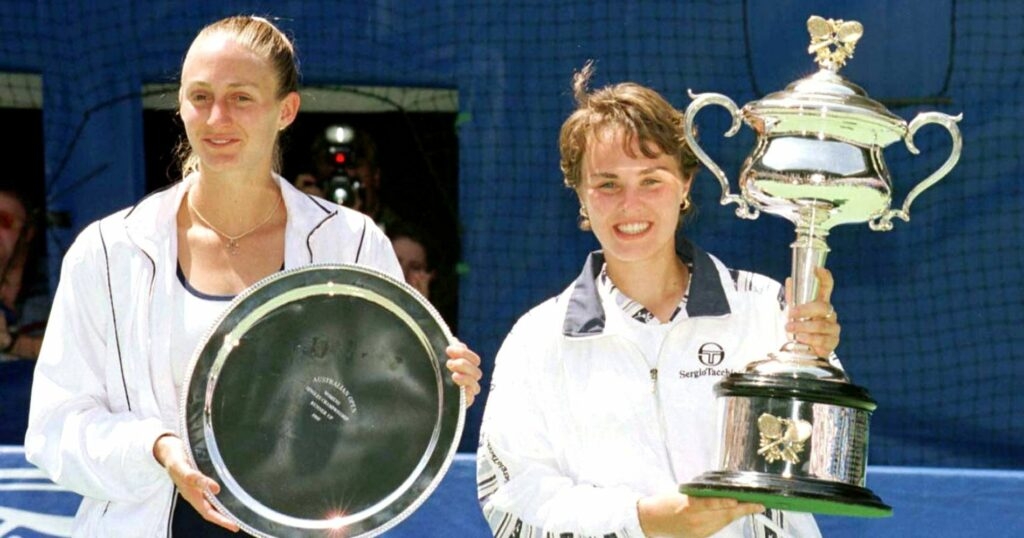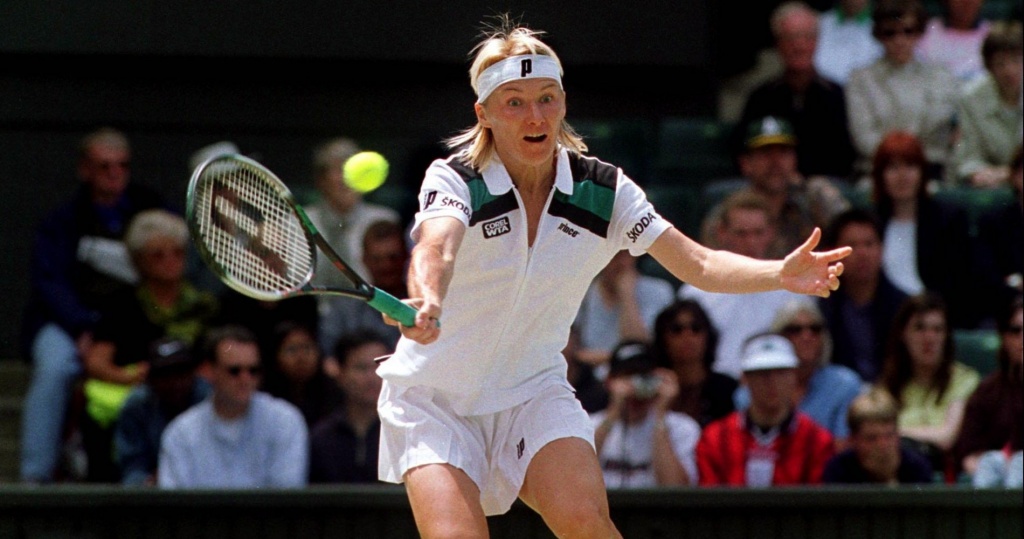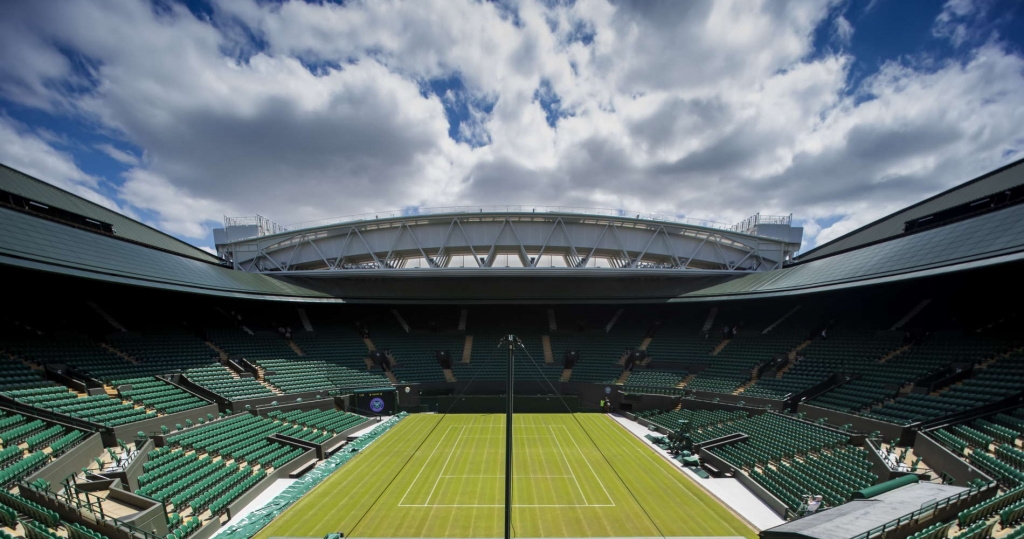July 5, 1997: The day Martina Hingis, aged 16, became the Wimbledon’s youngest Open Era champion
Every day, Tennis Majors takes you back in time to relive a tennis event which happened on this specific day. On this day in 1997, the Swiss Miss fought back from a set down to beat Jana Novotna and create history at the oldest tennis tournament in the world
 Martina Hingis at Wimbledon in 1997
Martina Hingis at Wimbledon in 1997
What exactly happened on that day?
On this day, July 5 in 1997, at the age of 16 years and nine months, Martina Hingis became the youngest woman in the Open Era to triumph at Wimbledon. The Swiss Miss, who had already become the youngest Australian Open champion in January and the youngest world No 1 in tennis history in March, defeated Jana Novotna in the final (2-6,, 6-3, 6-3) to add a second Grand Slam title to her list of achievements.
The players involved: Martina Hingis and Jana Novotna
- Martina Hingis: the young Swiss Miss
Martina Hingis was born in September 1980, and her mother Melanie Molitor named her after tennis legend Martina Navratilova. Taught by her mum, she soon became a real prodigy, winning the junior event at Roland-Garros at the age of 12.
Hingis started competing on the tour at 14, but was allowed to play only 15 tournaments before the age of 16, a rule she protested against, the familiar refrain being: “How can I enter the top 10 like that?”
Her game relied on an extraordinary hand-eye coordination, great tactics, amazing touch, and great anticipation. Early on in her career, she was said to lack power and a reliable second serve. The youngest player to ever win a match at the Australian Open in 1995, Hingis broke through in 1996. After defeating the undisputed world No 1, Steffi Graf, at the Italian Open in May, she reached the US Open semi-final, where Graf beat her 7-5, 6-3, and she finished runner-up at the season-ending WTA Championships (defeated by Graf, this time in five sets, 6-3, 4-6, 6-0, 4-6, 6-0).
Three months after her 16th birthday, she was already the sixth-ranked player in the world, and in January 1997, she became the youngest Grand Slam champion in the Open era, defeating Mary Pierce in the final (6-2, 6-2). These outstanding results made her the youngest player to ever climb to the world No 1 ranking, in March, aged 16 years and three months.

Unfortunately, Hingis had to skip most of the clay-court season, due to an injury caused by a fall while horse-riding, one of her passions outside of tennis. She wasn’t able to attend a single tournament on red dirt before Roland-Garros, where she nevertheless reached the final, defeated in a stunning upset by Iva Majoli (6-4, 6-2).
- Jana Novotna: the talented Czech in search of her first Grand Slam title
Jana Novotna was born in Czechoslovakia in 1968. With her serve-and-volley game, she broke into the top 100 in 1987, before claiming her first WTA title in 1988 in Adelaïde, defeating Jana Pospisilova in the final (7-6, 6-4). She obtained her first remarkable Grand Slam result at Roland-Garros in 1989 (defeated in the quarterfinals by Arantxa Sanchez, 6-2, 6-2), and, in the following years, she remained a solid top 10 player. Despite her consistency at the top level, she often struggled to keep her emotions under control when the stakes were high, and she had been defeated in her two appearances in a Grand Slam final, the first one at the 1991 Australian Open (lost to Monica Seles, 5-7, 6-3, 6-1), and then at Wimbledon, in 1993 (lost to Steffi Graf, 7-5, 1-6, 6-4).

Novotna’s loss in the 1993 final against Graf remained famous, as the Czech, after losing the first set, took the second set 6-1, and led 4-1 in the decider before collapsing and losing 6-4. During the trophy ceremony, she burst into tears in the arms of the Duchess of Kent. In 1995, in the Roland-Garros third round, she lost to Chanda Rubin after leading 5-0, 0-40 in the final set and failing to convert nine match points. Despite her amazing tennis skills, the knock on Novotna – at the time, at least – was that she didn’t have the mental strength required to triumph in major tournaments. Novotna had a much longer list of achievements in doubles, where she had already claimed nine Grand Slam doubles crowns and reached the world No 1 ranking in 1990.
The place: Wimbledon, south-west London

Wimbledon is the oldest and the most prestigious tennis tournament in the world. Held at the All England Lawn Tennis and Croquet Club since 1877, it moved to its current location in 1922, the same year when the Centre Court was built. Considered by many as the most intimidating court in the world, with its famous Rudyard Kipling quote above the entrance (“If you can meet with triumph and disaster and treat those two impostors just the same”), the Centre Court had seen the best players of all time competing for the title.
After the US Open switched to clay and then hard court in the 1970s, and after the Australian Open switched to hard court in 1988, Wimbledon remained the only Grand Slam tournament to be played on grass, a surface that is usually more suitable for serve-and-volley players. Not only did Wimbledon keep its surface, but it also maintained old-fashioned traditions such as its white dress code and the fact that the defending champion was always the first to play on the Centre Court.
The facts: Novotna started strong but it was Hingis who finished on a high
The 1997 Wimbledon Championships was a tournament full of surprises, where four of the top eight seeds were defeated before the fourth round, it was a relief for the organizers to have two of the favourites in the final: Martina Hingis, the world No 1, who had so far lost only one match in 1997, and Jana Novotna, world No 3, former finalist at the All England Club in 1993.
The Swiss Miss went through the draw without facing any seeded player, and did not drop a single set on her way to the final. In the semi-finals, she was expected to face Iva Majoli, who had defeated her in the French Open final just a few earlier, but the Croatian was eliminated by another teenager Anna Kournikova (7-6, 6-4), whom Hingis easily dismissed (6-3, 6-2). On the contrary, Novotna was pushed three times into a deciding set, her toughest match being her fourth round clash against Mary Joe Fernandez (5-7, 6-4, 7-5).
In the first set of this final though, it seemed that Novotna’s experience, combined with her natural grass-court game, could shake the outrageous confidence shown by the world No 1 throughout the fortnight. The Czech won the first set 6-2 : ”I felt like a beginner out there in the first set; she didn’t give me any opportunity to pass, and she was all over the net,” Hingis would later explain, according to The New York Times.
Hingis found her pace, sharpening her returns and her passing shots, and started taking the net as well to prevent Novotna from doing so. The Swiss took control of the match, and, although she had to come back from a break down at the start of the third set, she won the following sets, 6-3, 6-3.
”She saw the opening, and she went for it,” Novotna said. ”I think she felt she could really wear me down, but at least I went down fighting.”
The Czech had lost her second Wimbledon final, although this second loss was not as dramatic as her collapse against Graf in 1993. During the trophy ceremony, she pretended to steal the winner’s trophy, before of course handing it back to its actual owner.
”This time, it was a really good chance for me to win,” said Hingis. ”I was seeded No. 1, and I only lost to Steffi before at this tournament, so I thought maybe when she’s not here, I can win it too.”
Martina Hingis had just become the youngest female player in the Open era to triumph at Wimbledon, and only the second player to lift the trophy before the age of 17, along with Lottie Dod, the youngest winner of all-time, who had won the tournament in 1887 at the age of 15 years and 285 days.
What next? Hingis struggles to keep pace with the power game while Novotna finally wins Wimbledon in 1998
Martina Hingis would go on to triumph at the 1997 US Open (defeating Venus Williams in the final, 6-0, 6-4) and at the 1998 Australian Open (defeating Conchita Martinez, 6-3, 6-3). However, struggling to match up to the power of the young generation of players, including the Williams sisters, she would only claim one more major crown, at the Australian Open, in 1999.
However, Hingis would finish runner-up in no less than six other Grand Slam events. She would appear at the top of the WTA rankings for the last time on October 14, 2001, having occupied the spot for a total of 209 weeks.
After a heartbreaking loss to Jennifer Capriati in the 2002 Australian Open final, bothered by a foot injury, Hingis would announce her retirement in February 2003. She would return to the tour in 2006, but would never go beyond the quarter-finals of a Grand Slam singles tournament until she tested positive for cocaine at Wimbledon and was suspended at the end of the year. She would then come back a final time in the 2010s, in doubles, winning four additional Grand Slam titles before eventually retiring once and for all in 2017.
In 1998, Jana Novotna would eventually triumph at Wimbledon. This time, she would master her nerves to defeat world No 1 Hingis in the semi-finals (6-4, 6-4), before beating Nathalie Tauziat in the final (7-6, 6-4). She would also clinch the titles in doubles, partnering Hingis. Novotna would retire at the end of the following year, in 1999. The Czech would die of cancer at the age of 49 on November 19, 2017.













